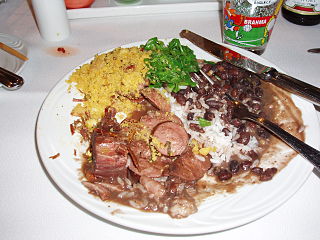
Latin American cuisine is the typical foods, beverages, and cooking styles common to many of the countries and cultures in Latin America. Latin America is a highly diverse area of land whose nations have varying cuisines. Some items typical of Latin American cuisine include maize-based dishes arepas, pupusas, tacos, tamales, tortillas and various salsas and other condiments. Sofrito, a culinary term that originally referred to a specific combination of sautéed or braised aromatics, exists in Latin American cuisine. It refers to a sauce of tomatoes, roasted bell peppers, garlic, onions and herbs.

Native American cuisine includes all cuisines and food practices of the indigenous peoples of the Americas. Contemporary Native peoples retain a varied culture of traditional foods, along with the addition of some post-contact foods that have become customary and even iconic of present-day Native American social gatherings. Foods like cornbread, turkey, cranberry, blueberry, hominy and mush have been adopted into the cuisine of the broader United States population from Native American cultures.

Italian cuisine is a Mediterranean cuisine consisting of the ingredients, recipes and cooking techniques developed across the Italian Peninsula since antiquity, and later spread around the world together with waves of Italian diaspora.

Chipa is a type of small, baked, cheese-flavored rolls, a popular snack and breakfast food in Paraguay. The recipe has existed since the 18th century and its origins lie with the indigenous Guaraní people. It is inexpensive and often sold from streetside stands and on buses by vendors carrying a large basket with the warm chipa wrapped in a cloth.

A fishcake is a culinary dish consisting of filleted fish or other seafood minced or ground, mixed with a starchy ingredient, and fried until golden.

Sopa paraguaya or Paraguayan soup is a traditional food of Paraguay, North-East of Argentina and the area of Brazil near to the Paraguayan border.. Literally meaning "Paraguayan soup", it is similar to corn bread. Corn flour, cheese and milk or whey are common ingredients. It is a spongy cake rich in caloric and protein content.

West African cuisine encompasses a diverse range of foods that are split between its 16 countries. In West Africa, many families grow and raise their own food, and within each there is a division of labor. Indigenous foods consist of a number of plant species and animals, and are important to those whose lifestyle depends on farming and hunting.

Vorí vorí is a thick, yellow soup with little balls made of cornmeal, corn flour, and cheese very usual in Paraguay and zones of the North-East of Argentina.

Mbeju or beiju is a starch cake sometimes made with fariña or manioc flour.

The chipa guasu is a cake made with corn grains, onions and Paraguayan cheese. It is one of 70 varieties of chipa, a traditional set of side dishes from Paraguay. It is often served in asados.

Kamby arro is a popular dessert in Paraguay. It is a thick cream obtained from cooking rice and cow's milk according to a precise process.
The Chipa so'o is a stuffed corn bread from the cuisine of Paraguay. It is a variation of chipá, a very common bread in Paraguay that is served alongside daily meals. It can be prepared with different fillings of ground meats or vegetables.

Lampreado, also known as Lambreado or “Payaguá Mascada”, is a dish typical of the cuisine of Paraguay, that has a high nutritional value.

Ka'í Ladrillo is a typical dessert of the Paraguayan cuisine prepared mainly with peanuts and molasses.
Paraguay cheese is a cows' milk cheese from Paraguay. It gives the Paraguayan cuisine a high value in calories and proteins, especially in the salted dishes recipes, very characteristic of the country and an important part of its culture.
Soyo is a thick soup of meat crushed in a mortar, seasoned with several spices and vegetables.

Mazamorra is the name for numerous traditional dishes from Iberian Peninsula and Latin America.

The cuisine of Paraguay is the set of dishes and culinary techniques of Paraguay. It has a marked influence of the Guarani people, in fusion with the Spanish cuisine and other marked influences coming from the immigration received by bordering countries such as Italian cuisine and Portuguese food. The gastronomy product of the syncretism and Hispanic-Guaraní fusion, is of greater weight in the Paraguayan history and considered the mother of the whole region, having Asunción as the starting point of many Spanish expeditions in the Southern Cone. It is worth clarifying that in society Paraguayan, the exchange of knowledge occurred between mestizos, criollos and guaraníes, before and even after the Jesuit missions. In 2017, the Ministry of the National Secretariat of Culture of Paraguay decided:
"Declare as 'Intangible Cultural Heritage of Paraguay' the production, handcrafted and traditional production of four typical Paraguayan meals still in force such as vori-vori, locro, Paraguayan soup and jopara and its recipes, knowledge, practices and knowledge that are passed down from generation to generation and document the material and immaterial elements associated with it as a cultural manifestation. "

Gambian cuisine is part of West African cuisine and includes the culinary practices and traditions of the nation of The Gambia. Common ingredients include fish, rice, peanuts, tomato, black-eyed peas, lemon, cassava, cabbage, salt, pepper, onion, chili, and various herbs. Oysters are also a popular food from the River Gambia, and are harvested by women.
















